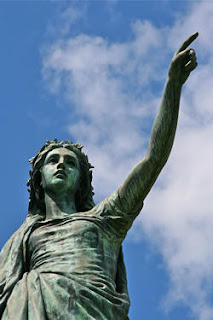Today, August 9th, is the feast of St. Jean Marie Vianney, the "Cur
e of Ars". Here is his incorrupt body, as we saw it in Ars, France, last July. The basilica where his body rests is named for his beloved Saint Philomena. Sr. Marie Helene Mohr writes in her book,
Saint Philomena, Powerful with God:
"When we say 'the Cure of Ars' we automatically think 'St. Philomena'. The saintly priest whose direction was characterized by common sense, remarkable insight, and supernatural knowledge credited his power to the only woman in his life, his 'dear little Saint', the Virgin-Martyr, Philomena. To his memory and that of Philomena, a basilica now stands, marking the spot where his humble village church sheltered the confessional which drew to him vast crowds from far and near."
In a tiny chapel near his home, this reliquary holds his incorrupt heart. I love the inscription in French around it...he is considered the patron saint of all the pastors "in the universe". Cur
e, (pronounced
cyur-ay)
, in French means pastor.
This sweet engraving on the side of the basilica makes me smile. The patron saint of parish priests humbly offers the basilica to Saint Philomena. Bruce Marshall, in his book,
Saints for Now, wrote: "He could not bring himself to believe that miracles could be operated through his intercession, and he was unwilling that others should attribute them to a merit which he was certain he didn't possess. He himself ascribed them to the intercession of St. Philomena."
My favorite anecdote was the one in which a mother begged and pleaded for the saintly priest to bless her sick child. When he did, and the child was miraculously cured, St. John Vianney fled to the sacristy, complaining,
"Oh, how I wish St. Philomena had cured him at home!"
And here is what I really went to Ars to see...the statue of St. Philomena that St. John Vianney enshrined in a side chapel of his original church. Many crutches and canes rested there, left behind by those who were cured. St. John Vianney told the people, "Go to Philomena, whatever you ask of her, she will obtain for you." He would often say, "My children, Saint Philomena has great power with God, and she has moreover a kind heart; let us pray to her with confidence; her virginity and generosity in embracing her heroic martyrdom have rendered her so agreeable to God that He will never refuse her anything that she asks for us."
The following story moves my heart...especially when one has been there and seen where it all happened! A Monsieur Massiat was invited by a friend to go to Ars during the life of St. John Vianney, although he had not been to Mass or the Sacraments since his First Communion. Here is Mr. Massiat's own account of what happened, as quoted by Fr. Paul O'Sullivan, O.P., in his book, Saint Philomena the Wonder-worker:
"We got to the church. My friend put me in the seat facing the sacristy. Shortly afterwards the door opened and the Cure, vested for Mass, made his appearance. His eyes met mine for one instant, but that glance went right to my heart. I felt myself crushed beneath his gaze. I bent my head and covered my face with my hands. All during the Mass, I was immovable. When it ended, I attempted to lift my head and got up to leave the church. Just as I passed the sacristy door, I heard the words, 'Get out, all of you, all out,' and a long bony hand rested on my arm, and I felt myself drawn irrestistibly into the sacristy, as by an invisible force. The door closed on me. I felt myself again beneath that gaze that seemed to crush me. I blurted out a few confused words: 'Reverend Father, I have a burden on my shoulders that weighs me down.' Then I heard what seemed an angelic voice, such a one as I had never heard before, so sweet that it did not seem to proceed from mortal man.
"'You must get rid of the burden at once. Go on your knees, tell me your poor life. Our Lord will take the burden, my friend.' Then I commenced my Confession, it was the story of all my life since my First Communion. Little by little, I felt relieved, then consoled, and finally completely at rest. When I had finished the saintly priest added: 'Come back tomorrow, but now you will go to the altar of St. Philomena and tell her to ask of God your conversion.' I did not weep in the sacristy, but I confess that I wept abundantly at the altar of St. Philomena."












